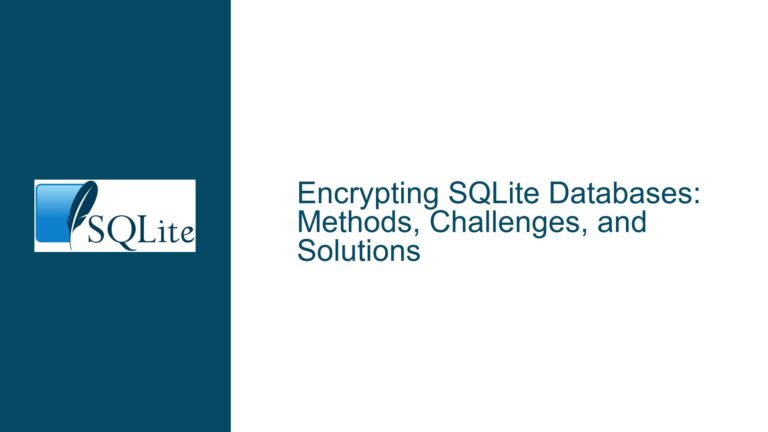Recovering Encrypted SQLite Database Password from SPB Wallet Backup
Understanding the SPB Wallet Backup and Its SQLite Encryption
The core issue revolves around recovering a password from an encrypted SQLite database that was created by a now-defunct application called SPB Wallet. The user stored a critical password in this application approximately eight years ago and has since forgotten the software’s password. The application utilized SQLite 3 as its underlying database technology, and the database is likely encrypted. The challenge lies in accessing the encrypted data without the original encryption key, especially since the software’s developers and support channels are no longer available.
SQLite databases are often used in applications like SPB Wallet due to their lightweight nature and ease of integration. However, when encryption is applied, the database becomes inaccessible without the correct key. Encryption is typically implemented to protect sensitive data, such as passwords, from unauthorized access. In this case, the encryption key is derived from the user’s password, meaning that without the password, the data remains locked.
The user’s situation is further complicated by the absence of any support from the original developers. This means there are no official tools or documentation available to assist in recovering the password or decrypting the database. The user’s only option is to explore potential methods to bypass or recover the encryption key, which is a technically challenging and ethically sensitive task.
Why Encryption Makes Password Recovery Difficult
Encryption is designed to be a one-way process without the correct key. In the context of SPB Wallet, the password provided by the user is likely used to generate an encryption key through a key derivation function (KDF). Common KDFs include PBKDF2, bcrypt, or scrypt, which are designed to be computationally intensive to prevent brute-force attacks. This means that even if the user attempts to guess the password, the process would be prohibitively slow without significant computational resources.
Additionally, the encryption algorithm used by SPB Wallet is unknown. SQLite itself does not provide built-in encryption; instead, it relies on extensions like SQLCipher or custom implementations. Without knowing the specific encryption method, it is impossible to apply a targeted decryption strategy. The lack of documentation or support from the developers further compounds this issue, as there is no way to determine how the encryption was implemented.
The ethical implications of attempting to bypass encryption must also be considered. While the user has stated their intentions are legitimate, the process of decrypting a database without the original key can be seen as a violation of privacy and security principles. This is why most encryption systems are designed to be irreversible without the key, ensuring that data remains secure even if the software or its developers are no longer available.
Exploring Potential Solutions and Their Limitations
Given the challenges outlined above, there are limited options for recovering the password or decrypting the database. One approach is to attempt a brute-force attack, where every possible password combination is tried until the correct one is found. However, this method is only feasible if the password is relatively simple and short. Modern encryption standards and KDFs make brute-forcing impractical for longer or more complex passwords.
Another option is to search for any remnants of the password that might be stored elsewhere. For example, the user might have written down the password, saved it in another application, or used a similar password for other accounts. If any part of the password can be recalled, it might be possible to narrow down the possibilities and reduce the time required for a brute-force attack.
If the user has access to the original device where SPB Wallet was installed, there might be cached data or temporary files that could provide clues about the password. However, this is unlikely after eight years, especially if the device has been reformatted or replaced. Additionally, any cached data would still be encrypted, making it difficult to extract useful information.
In some cases, third-party tools claim to decrypt SQLite databases, but these tools are often unreliable or malicious. Without knowing the specific encryption method used by SPB Wallet, there is no guarantee that such tools would work. Furthermore, using these tools could expose the user to security risks, such as malware or data theft.
Ultimately, the most realistic solution is to accept that the data may be permanently inaccessible. Encryption is designed to protect data from unauthorized access, and without the key, there is no practical way to bypass it. While this is undoubtedly frustrating for the user, it underscores the importance of securely storing and managing passwords, especially for critical data.
Best Practices for Preventing Similar Issues in the Future
To avoid similar situations in the future, users should adopt robust password management practices. This includes using a reputable password manager to store and generate strong, unique passwords for each application. Password managers often include features for securely backing up and recovering passwords, reducing the risk of data loss.
Additionally, users should keep detailed records of important passwords, either in a secure physical location or through a trusted digital backup system. Regularly updating and testing backups can help ensure that critical data remains accessible even if the original application or device is no longer available.
For developers, this case highlights the importance of providing clear documentation and support for encryption and password recovery processes. Even if a project is discontinued, making this information available to users can help them manage their data effectively and avoid situations where critical information becomes inaccessible.
In conclusion, while the user’s situation is challenging, it serves as a valuable lesson in the importance of encryption and password management. By understanding the limitations of encryption and adopting best practices, users can better protect their data and avoid similar issues in the future.






